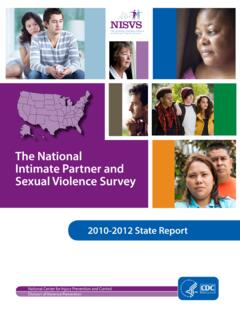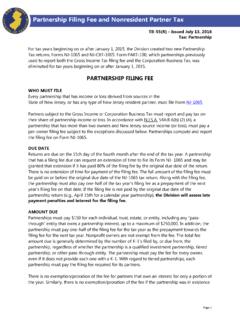Transcription of Full Report of the Prevalence, Incidence, and Consequences of …
1 Department of JusticeOffice of Justice ProgramsNational Institute of Justiceresearch reportFull Report of thePrevalence, Incidence, and Consequences ofViolence Against WomenFindings From the National Violence Against Women Department of JusticeOffice of Justice Programs810 Seventh Street , DC 20531 Janet RenoAttorney GeneralDaniel MarcusActing Associate Attorney GeneralMary Lou LearyActing Assistant Attorney GeneralJulie E. SamuelsActing Director, National Institute of JusticeOffice of Justice ProgramsNational Institute of JusticeWorld Wide Web SiteWorld Wide Web Report of thePrevalence, Incidence, and Consequences of ViolenceAgainst WomenPatricia TjadenNancy ThoennesNovember 2000 NCJ 183781 Findings From the NationalViolence Against Women SurveyJulie E.
2 SamuelsActing Director, National Institute of JusticeStephen B. ThackerActing Director, National Center for Injury Prevention and ControlThis research was sponsored under award number 93 IJ CX 0012 by the National Institute of Justice, Office ofJustice Programs, Department of Justice, and the Centers for Disease Control and Prevention. Findings andconclusions of the research presented here are those of the authors and do not necessarily reflect the official positionor policies of the Department of National Institute of Justice is a component of the Office of Justice Programs, which also includes theBureau of Justice Assistance, the Bureau of Justice Statistics, the Office of Juvenile Justice and DelinquencyPrevention, and the Office for Victims of FOR DISEASE CONTROLAND PREVENTIONiiiExecutive SummaryKey IssuesResearch on violence against women has ex-ploded in the past 20 years.
3 Particularly in theareas of intimate partner violence and sexualassault. Despite this outpouring of research,many gaps exist in our understanding of vio-lence against women. For instance, reliableinformation on minority women s experienceswith violence is still lacking. Few empiricaldata exist on the relationship between differentforms of violence against women, such asvictimization in childhood and subsequentvictimization. Finally, empirical data on theconsequences of violence against women, in-cluding their injury rates and use of medicalservices, are further understanding of violence againstwomen, the National Institute of Justice andthe Centers for Disease Control and Preventionjointly sponsored, through a grant to the Cen-ter for Policy Research, a national survey thatwas conducted from November 1995 to May1996.
4 The National Violence Against Women(NVAW) Survey sampled both women andmen and thus provides comparable data onwomen s and men s experiences with to the survey were asked about: Physical assault they experienced as chil-dren by adult caretakers. Physical assault they experienced as adultsby any type of assailant. Forcible rape and stalking they experiencedat any time in their life by any type who disclosed that they had beenvictimized were asked detailed questions aboutthe characteristics and Consequences of theirvictimization, including injuries they sustainedand their use of medical NIJ Research Report presents findingsfrom the NVAW Survey on the prevalenceand incidence of rape, physical assault, andstalking; the rate of injury among rape andphysical assault victims; and injured victims use of medical services.
5 The data show thatviolence is more widespread and injurious towomen s and men s health than previouslythought an important finding for legislators,policymakers, intervention planners, andresearchers as well as the public health andcriminal justice FindingsAnalysis of survey data on the Prevalence, incidence, and Consequences of violenceagainst women produced the following results: Physical assault is widespread among adultsin the united states : percent of surveyedwomen and percent of surveyed mensaid they were physically assaulted as a childby an adult caretaker and/or as an adult byany type of attacker.
6 An estimated millionwomen and million men are physicallyassaulted annually in the united states . Many American women are raped at anearly age: Of the percent of all womensurveyed who said they had been the victimof a completed or attempted rape at sometime in their life, percent were youngerthan age 12 when they were first raped, percent were ages 12 to 17. Thus, moreivthan half (54 percent) of the female rapevictims identified by the survey wereyounger than age 18 when they experiencedtheir first attempted or completed rape. Stalking is more prevalent than previouslythought: percent of surveyed women percent of surveyed men reported beingstalked at some time in their life; percentof women surveyed and percent of mensurveyed reported being stalked in the 12months preceding the survey.
7 Approxi-mately 1 million women and 371,000 menare stalked annually in the united states . American Indian/Alaska Native womenand men Report more violent victimizationthan do women and men of other racialbackgrounds: American Indian/AlaskaNative women were significantly morelikely than white women, African-Americanwomen, or mixed-race women to Report theywere raped. They also were significantlymore likely than white women or African-American women to Report they were Indian/Alaska Native men weresignificantly more likely than Asian men toreport they were physically assaulted. Rape prevalence varies between Hispanicand non-Hispanic women: Hispanic womenwere significantly less likely than non-Hispanic women to Report they were rapedat some time in their life.
8 There is a relationship between victimiza-tion as a minor and subsequent victimiza-tion: Women who reported they were rapedbefore age 18 were twice as likely to reportbeing raped as an adult. Women who re-ported they were physically assaulted as achild by an adult caretaker were twice aslikely to Report being physically assaultedas an adult. Women who reported they werestalked before age 18 were seven timesmore likely to Report being stalked as anadult. Women experience more intimate partnerviolence than do men: percent of sur-veyed women, compared with percentof surveyed men, reported they were physi-cally assaulted by a current or formerspouse, cohabiting partner , boyfriend orgirlfriend, or date in their lifetime; per-cent of surveyed women and percent ofsurveyed men reported experiencing suchviolence in the previous 12 months.
9 Ap-proximately million women and 835,000men are physically assaulted by an intimatepartner annually in the united states . Violence against women is primarily inti-mate partner violence: percent of thewomen who reported being raped, physi-cally assaulted, and/or stalked since age18 were victimized by a current or formerhusband, cohabiting partner , boyfriend, ordate. In comparison, only percent ofthe men who reported being raped and/orphysically assaulted since age 18 werevictimized by such a perpetrator. Women are significantly more likely thanmen to be injured during an assault: of female rape victims, comparedwith percent of male rape victims,reported being injured during their mostrecent rape; percent of female physicalassault victims, compared with percentof male physical assault victims, reportedbeing injured during their most recentphysical assault.
10 The risk of injury increases among femalerape and physical assault victims whentheir assailant is a current or former inti-mate: Women who were raped or physi-cally assaulted by a current or formerspouse, cohabiting partner , boyfriend, ordate were significantly more likely thanwomen who were raped or physically as-saulted by other types of perpetrators to re-port being injured during their most recentrape or physical Approximately one-third of injured femalerape and physical assault victims receivemedical treatment: percent of thewomen injured during their most recentrape and percent of the women injuredduring their most recent physical assaultreceived medical ImplicationsInformation generated by the NVAW Surveyvalidates opinions held by professionals inthe field about the pervasiveness and injuriousconsequences of violence against study s findings on the frequency withwhich women are victimized by intimate part-ners confirms previous reports that violenceagainst women is primarily intimate partnerviolence.

















